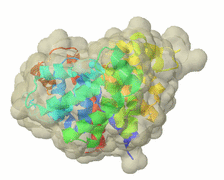Jmol toolkit cookbook
|
Enhanced figures in Crystallography Journals Online are interactive visualizations of crystal and molecular structures that appear in many journal articles. They use the open-source Java program Jmol and can contain author-created scripts to show different aspects of the structure. This page provides 'recipes' suggested by users for achieving various effects in enhanced figures using the Jmol toolkit. The authoritative documentation for the Jmol scripting language is at http://chemapps.stolaf.edu/jmol/docs/ and the toolkit itself has an online manual, but the tips and tricks documented here may provide you with quick and easy ways to achieve some common requirements that are not obvious from the formal docs. If you have managed to solve a problem with the toolkit that other users may also have to face, send your solution to [email protected]. How to...? |

Click on the figure for an example. |
Draw a dashed line between two atomsGo to the select/label tab. Turn 'selection haloes on' to see which atoms are selected at any time. Under 'Select items' click 'none' (all the selection haloes should disappear), then 'individual atoms'. Now click on the two atoms you wish to join; ensure their selection haloes light up. If you click on the wrong atom, click again to unselect it. Now under 'Colour/style of selected items' go to the 'bonds: width' drop-down menu and choose 'connect all selected'. If you want to change the default width, you can then select a different width from the same drop-down menu. Select your chosen colour (and translucency if required). Under 'bond order' select 'partial' or 'hydrogen bond' to get a dashed line. If you need to, you can repeat this process, but remember to unselect the atoms current selected, or your new bonds will also include them. When you have finished, 'select all' then turn off selection haloes. Draw space-filling residues within a protein cartoonGo to the select/label tab. Turn 'selection haloes on' to see which atoms are selected at any time. Under 'Select items' click 'none' (all the selection haloes should disappear), then 'by group'. Click on any atom in the residue of interest. If you have difficulty in identifying the specific residue, mouse over a candidate atom. In a few seconds, a pop-up will show the atom label, usually with terms identifying residue or chain. When you have selected the residue you want, use the 'atoms' options under 'Colour/style of selected items' to render space-filling atoms, modify the colout etc. You may select further residues by clicking on atoms within specific groups. If you inadvertently select the wrong residue, just click again to unselect it. When you have finished, 'select all' then turn off selection haloes. |


 menu
menu



